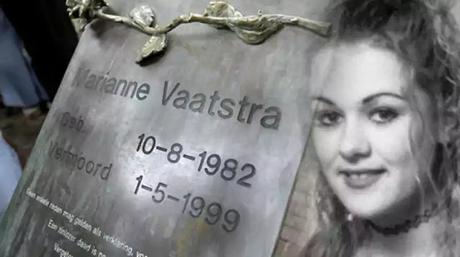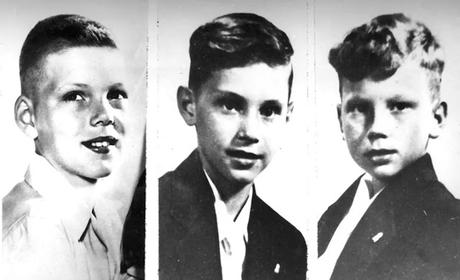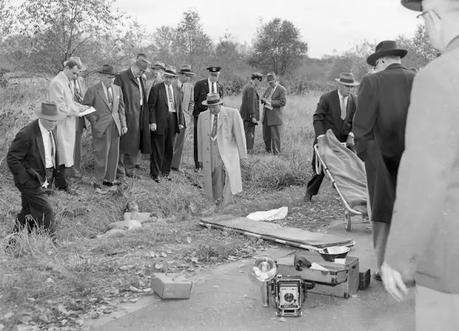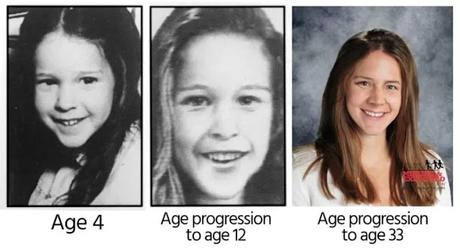Today, we're taking a look at five cases that were solved in some of the strangest and most unexpected ways. Many of these cases were solved in such weird ways that they will leave you questioning just what the people involved were thinking.
Marianne Vaatstra Case

pic credit: Google Images
Today's first strange solved case came to a resolution in one of the most startling and tidy ways that we've ever come across, and I know you won't see it coming. In 1999, the small village of Veenklooster, in the Netherlands made national headlines for a tragic reason.
A 16-year-old schoolgirl named Marianne Vaatstra went missing on May 1st. She was last seen while riding her bike from the village of Kollum to where her parents lived in De Westereen. It wasn't too far, just over 20 minutes on a bike, but she never made it.
Marianne's body was discovered the next day, where it had been left in a remote field near Veenklooster. Horrifically, she had been strangled, and her throat was cut. There was also evidence that she'd been assaulted before her death. Investigators found traces of both blood and semen at the crime scene and on Marianne's body.
As tragic as her death was, investigators knew that this evidence would be vital to help catch her killer. As well, investigators found a Playboy cigarette lighter in Marianne's bag, and it had traces of DNA that matched the same sample that was found on her body.
With all of this DNA evidence, investigators thought it would be easy to track down Marianne's killer, but they had no idea of the difficult road ahead. As news spread about the brutal and shocking nature of Marianne's death, the public became increasingly outraged, and desperately wanted the guilty person to be found.
In response to the public pressure, investigators mistakenly connected her death to a center for asylum seekers. The center was located near the field where Marianne's body was found. The angry public rioted, but the two suspects were eventually cleared, as their DNA didn't match the sample from Marianne's body.
However, by the time they were dismissed as suspects, any other leads also dried up. Focusing again on the DNA sample, police asked hundreds of men to voluntarily give their DNA to compare. The investigators believed that the killer had to be a local because of the Playboy cigarette lighter, which could be bought locally. But none of the DNA matched.
With this, the case went cold. Marianne's death soon became the Netherlands' most infamous unsolved murder. In 2012, the case reopened, and in a last-ditch attempt to solve Marianne's death, the police began kindly asking for all men living in the five-kilometer radius of the crime scene to willingly give their DNA.
That's right, they just asked nicely, and hoped that everyone would comply. But why would the killer agree to voluntarily give their DNA to police when they had escaped justice for 14 years? Well, if they were smart, they wouldn't give up the one thing that would finally implicate them in Marianne's death.
And surprisingly, over 6,500 men from 12 different villages agreed to give a DNA sample to the police. Even more shocking, though, was the fact that one of the samples came back as a 100% match to the suspect's DNA.
The man, identified named as Jasper S., was arrested at his farm at Oudwoude, which was only two and a half kilometers from where Marianne's body was found. The married father of two was 45 years old when arrested, and would have been 31 at the time that Marianne was killed.
He had no record of any other criminal activity. Jasper S. gave his DNA sample voluntarily as part of the police sweep, but what was he thinking? It's hard to know exactly. Perhaps he thought that, somehow, he wouldn't be caught.
No matter what he thought would happen, 14 years after Marianne's death, Jasper S. eventually confessed. He said he forced Marianne into the field with him by threatening her with a pocket knife, the same weapon he used to cut her throat. Though he claimed to have no idea what he was doing at the time, Jasper S. was convicted and sentenced to 18 years in prison.
Marc Feren Claude Biart Case

pic credit: CNN
The following case is a good reminder that sometimes, the call to fame can be someone's downfall. Marc Feren Claude Biart was living in the Dominican Republic for five years when he decided to begin a YouTube channel with his wife, where he filmed himself cooking Italian food.
He had the experience to share with the world, as he had previously worked at a restaurant in Italy, but as it turns out, Biart was in the Dominican Republic because he was hiding from the police. In fact, Biart had been avoiding police detection for about seven years, after he was allegedly linked to trafficking drugs from the Netherlands in 2014.
Police have revealed that they suspect Biart is a member of the notorious European 'Ndrangheta crime syndicate and is suspected of working for the Cacciola clan. The Mafia gang is one of the most powerful and feared in Europe, originating in the Calabria region of Italy.
Interpol has said that branches of 'Ndrangheta exists on every continent in the world. Biart was described as one of 'Ndrangheta's most dangerous fugitives. With all of this in mind, it makes sense that he would wanna keep a low profile while hiding from the police.
Living like a ghost while in the Dominican Republic, he kept to himself, didn't visit the Italian community in the area, and locals-only knew him by his first name. In fact, he kept such a low profile, investigators struggled to find any trace of him, but still, they never stopped looking and had even recently decided to attempt a new approach, open-source intelligence.
But he had one big downfall, his love for cooking Italian cuisine. When he filmed his YouTube videos, Biart always made sure that his face never appeared on camera. That way, no one would be able to identify him. However, he had very distinctive tattoos that were clearly visible in the videos.
These tattoos were a dead giveaway to his true identity. Somehow, these cooking videos made their way to investigators, who immediately recognized Biart by his tattoos. It isn't clear exactly how they came across the cooking videos, if it was part of their investigation, or if someone else noticed the tattoos and sent in a tip.
It also isn't clear exactly how many videos Biart posted to YouTube, or how long he was making them before his channel was taken down. In March 2021, Biart was arrested in Boca Chica Dominican Republic, before he was extradited to Italy to face trial for drug trafficking charges.
If Biart hadn't been tempted to post his Italian cooking tutorials to YouTube, who knows when, or even if, he'd ever be caught. Other members of the 'Ndrangheta crime syndicate, Biart included, are currently facing one of Italy's biggest Mafia trials on charges of kidnappings, murders, and international drug trafficking.
At the pretrial hearing, the enormous case took over three hours just to read the names on the list of 350 defendants. Due to the size of the trial, it will likely take place over the next few years, so we won't know the result of Biart's case until then.
The German town of Schwelm Case

pic credit: Insider
The next case we have for you is one of the worst kinds of luck if you'll excuse the pun, and you'll know exactly what I mean by that in a minute. Back in March 2012, a house in the western German town of Schwelm was burglarized. As if that wasn't bad enough, the thief also added insult to injury.
While going through the home, the burglar decided to stop and take a snack break, taking a few bites out of a piece of a sausage the homeowner had bought, known as wurst in Germany. Even ruder, they left the half-eaten sausage at the crime scene. Clearly, they didn't like what they were eating.
Obviously integral to the case, it wasn't released exactly what kind of sausage it was, though the police described it as being of the hard variety. The irony is the police were able to lift a DNA sample of the suspect from the saliva left on the half-eaten sausage. If they'd finished eating it, there wouldn't have been anything to test for DNA.
Seeking the burglar's identity, the sample was uploaded to various databases, but sadly, no match ever came back. When no other leads were found and the burglary was eventually forgotten as more urgent cases came up, the burglar managed to avoid being caught for any other crimes, and kept their DNA out of the databases, leading investigators to ponder the mystery of the sausage bandit, for years.
It wasn't until 2021, nine years later, when that all changed. A man was detained in France after he was involved in an unrelated violent crime, and when the police took his DNA, it came back as a match for the wurst-eating burglar.
The suspect was a 30-year-old Albanian citizen. It isn't clear exactly what their most recent crime was, but they were officially connected to the 2012 burglary.
Despite this, the suspect will likely never be prosecuted for the crime or be extradited to Germany, as the statute of limitations on the burglary has expired. The other crime must have been relatively minor, as the police have said that the suspect is currently free.
Robert Peterson & Brothers Case

pic credit: NY Daily News
The next strange solved case we're going over today shows that sometimes questions in one case can lead to answers in another. It was a rainy October night in 1955 when three boys were hitchhiking for a ride home in Chicago's Northwest side.
14-year-old Robert Peterson, along with brothers 13-year-old John and 11-year-old Anton Schuessler Jr., had spent the day out, exploring the city streets, watching a movie, and spending time at two bowling alleys, but none of the boys made it back home that night, and they were never seen again. Tragically, their families' worst fears came true.
Sometime later, a salesman stopped to eat his lunch near a forest preserve. Looking down at a nearby ditch, he at first thought that what he was looking at were discarded department store mannequins, but then he looked closer. It was the bodies of the three missing boys lying naked in a ditch.
An autopsy determined that all three were killed by strangulation. The boys appeared to have struggled and fought against their attacker as there was evidence that they had been beaten. One of the boys had cuts on his scalp in a jagged pattern that appeared to have been made by a rake. But the identity of their killer wasn't so clear.
Back in 1955, the deaths of the three boys shocked everyone. You have to remember that at this time, people thought that the world was safe for children, that they could be left alone to explore the streets, and nothing bad would happen to them, but the deaths of the three boys proved that tragically, that wasn't true at all.
In response to the public's horror, police began an enormous investigation. They interviewed a total of 43,740 people in their search for the boys' killer, but even after talking to thousands of possible suspects, no one was ever charged.
As the story of the boys spread, a witness came forward to say that they had seen a car, one she believed to be a Packard, pick up the three boys. With this information, police interviewed 970 Packard owners, but they still didn't find anyone that connected to the case.
Eventually, the three young boys' case went cold, and it stayed that way for a long time. That is, until Helen Vorhees Brach, a multimillionaire widow, went missing in 1977. What does this have to do with three boys killed in 1955? Well, very little, directly, but also quite a bit, as you'll see.
Brach, known as the Candy Lady after she married into the E.J. Brach & Sons candy company family, was a horse enthusiast, and frequently bought high-end thoroughbred horses. In the mid-'70s, she purchased racehorses from both the Bailey Stables and Country Clubs Stables owned by Richard Bailey, but rather than buying the show or racehorses, Brach fell for an elaborate scheme where she was actually sold third-rate horses, but for top prices.
Brach was swindled out of hundreds of thousands of dollars in horse fraud, including the purchase of three secretly rundown racehorses in 1975 for $98,000, a sum which is nearly half a million today. Brach was suspicious and eventually hired an independent appraiser to check the horses she'd purchased for authenticity.
The appraiser told her that the horses were essentially worthless. Upon learning that she'd been swindled in horse fraud, Brach threatened to go to the authorities and expose the criminal ring. But then she disappeared. She vanished on February 17th of 1977, after she'd gone alone to Minnesota for a physical with the Mayo Clinic.
She was last seen alive when buying cosmetics at the clinic's counter, but never again. Her disappearance has since become Chicago's longest-lasting murder mystery. The case eventually went cold, and Brach was declared legally dead in May 1984. Her body was never found.
Investigators suspect that the reason for this was because it was probably dissolved in a chemical vat or blast furnace, in 1977. When the police reopened her case in 1989, they came to believe that Brach's sudden disappearance and supposed death was linked to the criminal activity at the stables owned by Richard Bailey.
Police charged Bailey with soliciting Brach's murder, along with 23 other people, for various schemes, including horse fraud, and even plans to kill expensive horses to collect insurance payments.
After pleading guilty to charges of racketeering and conspiracy, which included his fraudulent horse sales to Helen Brach, as well as many other women, Richard Bailey was convicted, but he wasn't convicted for Brach's disappearance and death.
In fact, no one has ever been found guilty in connection to Brach's case, leaving it still unsolved today. He ended up serving most of his 30-year sentence but was released in July 2019, at 90 years old, and once he was released, Bailey spoke about the case.
He said that about half a dozen people were involved in planning Brach's death, as well as killing her. Most investigators agree that Bailey may have been involved in arranging Brach's death, but he didn't actually commit the crime himself.
So where do the three boys killed in 1955 fit into this? Well, during the investigation into Brach's disappearance, the detectives stumbled upon information they weren't even looking for. In an interview, one of the informants said that they had heard about a stable owner who had bragged about killing three boys all the way back in 1955.
This stable owner was Kenneth Hansen. Hansen and his wife had opened up their own stables in the 1960s, called Camelot Stables, which they owned until they sold them in the late 1980s. Investigators looked deeper into Hansen and found another witness, who claimed that on a night in 1964, Hansen had gotten drunk, and confessed that he had picked up three boys and taken them to a barn.
He claimed to have assaulted the two Schuessler brothers before he grabbed Robert Peterson by the throat and accidentally strangled him to death. After that, he said he had no other choice but to kill the other two kids. Hansen was arrested in 1994 and charged with arson from a fire back in 1972. The fire had destroyed one of his competitors' stable businesses, which also killed 36 horses.

pic credit: Google Images
Later that same day, Hansen was also charged with the killing of the three boys. It was then revealed that Hansen might be connected to another fire, but this one may have had something to do with the three boys.
Back in May 1956, seven months after the three boys were killed, police began publicly discussing that they may need to exhume the boys' bodies to look for more evidence. That same month, there was a fire at the Idle Hour Stables where Hansen worked.
The fire destroyed a barn filled with hay, harnesses, and saddles, leaving nothing behind but a pile of smoldering ashes. Police have said that they think Hansen set the fire to the barn in order to destroy any clues to the boys' deaths that may have still been there.
Just one month after this fire, the boys' bodies were exhumed, and evidence of hay was found in their lungs, but any chance that the investigators could connect it to a crime scene had likely burned down. In a sick twist of fate, Hansen had actually been interviewed by police during their initial investigation, but he didn't become a suspect.
Hansen had simply walked away and moved on with his life, getting married, and having new sons of his own. In 1995, Hansen went on trial for the murder of the three boys. He proclaimed his innocence the entire time.
The prosecution was all based on testimony because there was no physical evidence after 40 years. During the trial, the defense blamed the boys' deaths on one of the country's most horrifying serial killers, who were living in the area at the time, John Wayne Gacy, but this deflection had one big issue.
Gacy was only 13 in 1955, and probably not strong enough to commit the crime. After just two hours, the jury found Hansen guilty, and he was given a sentence of 200 to 300 years in prison. In 2,000, this conviction was overturned, but the retrial resulted in his conviction once again.
In 2007, Hansen was waiting for another appeal, but he died of natural causes in prison. If Helen Vorhees Brach had never gone missing, the three young boys' killer may never have been found, even if her own death has yet to be solved.
Nyleen Kay Marshall Case

pic credit: morbidology
Today's final case has one very unexpected twist and almost seems like something out of a novel rather than real life. It was June 1983, when Nyleen Kay Marshall went missing. The four-year-old was on a picnic with her family near her hometown in Clancy.
She'd been playing with some other children when a man jogged by, and suddenly, Nyleen was gone. Her family searched for her, but there was no sign of what had happened to the little girl. Six months after she went missing, Nyleen's parents received the first letter. Two more letters would eventually arrive. All claimed to have been written by the person who took Nyleen.
The next letter didn't show up until three years later, and this one was sent to the investigators looking into the case. It was postmarked from Madison, Wisconsin, and was filled with information. The writer said that they were raising Nyleen under her middle name, Kay, and they said that they traveled with her frequently.
Strange thing for an abductor to write, isn't it? It was almost as if they were bragging. At this same time, someone continued to call the missing children networks in order to talk about Nyleen's case as though they were keeping tabs on it.
These calls were also from Wisconsin, like the letters. Nyleen Marshall's disturbing disappearance was featured on the November 1990 episode of Unsolved Mysteries. Shockingly, someone recognized the picture of the missing little girl.
The viewer was a school official, who was sure that Nyleen was a little girl in their class, living under a different name. But here's the thing. Even though the picture of Nyleen bore a resemblance to the little girl the viewer knew, it wasn't her, but they didn't know that, and still brought the little girl to the police's attention.
Eager to return Nyleen to her parents, police arrived at the home where the little girl was staying in Point Roberts, a small island near the Canadian and US border in Washington state on December 21st. That's when they realized something wasn't quite right.
It wasn't Nyleen, but in a truly shocking twist, the little girl in question, Monica Judith Bonilla, was another child who had also been abducted. Monica Bonilla was five when her parents had separated, and a custody battle over her began.
During these disagreements, Monica's non-custodial father, Guillermo Bonilla, allegedly took her from his estranged wife's house in the Los Angeles suburb of Burbank, on September 22nd, 1982. The two seem to disappear completely. Desperate to find her daughter, Rosemary Levi ended up spending $20,000, hiring detectives to track down Monica.
In an effort to find her, Monica's face was even plastered all over billboards, shopping bags, and cold drink cups throughout all of Los Angeles. Two years after she went missing, Monica was actually one of the first children to be pictured on milk cartons, in a California-wide campaign to find missing children.
Monica didn't even know she was missing, or that she'd been taken from her mother. In fact, she'd been told that her mother had died, and she was given another name to hide her true identity. For over seven years, Monica and her father lived under the radar.
That is until a good Samaritan got her confused with Nyleen Marshall. In 1990, Monica, now 13, was finally reunited with her mother, who had never stopped looking for her. While Monica was missing, Levi had refused to celebrate Christmas and Mother's Day, hoping to one day celebrate the holidays with her daughter, again.
In the almost eight years since her daughter was missing, Levi eventually remarried and had another child, a son, who was six when he finally met his half-sister for the first time. After Monica was recovered, her father was held in Bellingham, Washington, while he waited for extradition and arraignment in Los Angeles on a charge of parental child abduction.
Although Monica's case eventually came to a happy ending, tragically, Nyleen has never been found. To this day, her disappearance remains an unsolved mystery.

